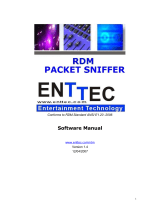
RDS 4 and RDS 8
User Manual
Firmware V1.0
Table of Contents
Models RDS4 and RDS8 ......................................................... 1
Warranty .......................................................................................... 4
Contacting ENTTEC ....................................................................... 4
Getting Support ................................................................................ 4
Getting to know your RDS4 or RDS8 ............................................ 5
Features ............................................................................................ 5
Layout .............................................................................................. 6
Connecting the RDS4 or RDS8 ....................................................... 7
Power supply ........................................................................... 8
DMX Out ................................................................................. 8
DMX In .................................................................................... 8
Electrical Isolation ................................................................... 8
Powering up the RDS4 or RDS8................................................. 9
Using the RDS4 or RDS8 ............................................................... 9
Normal Mode...............................................................................9
Filtered Mode............................................................................ 10
When to use Filtered Mode: ................................................. 10
Bypassed Mode..........................................................................10
.................................................................................................. 10
When to use the Bypass Mode: ............................................ 11
Appendix 1 - Connector Pinouts ................................................ 12
DMX OUT.................................................................................12
DMX IN.....................................................................................12
Appendix 2 - FCC Declaration .................................................... 13
Federal Communications Commission (FCC) Declaration
of Conformity .................................................................. 13
Appendix 3 - EEC Declaration .................................................... 15
3



























